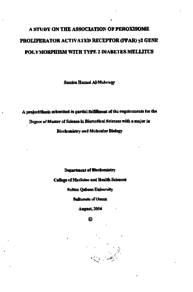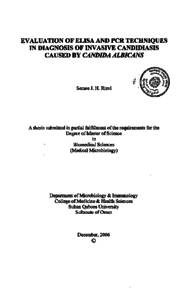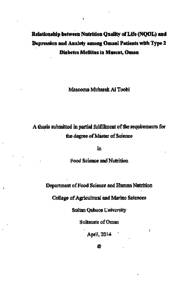Document
A study on the association of peroxisome proliferator activated receptor (PPAR)y2 gene polymorphism with type 2 diabetes mellitus.
Publisher
Sultan Qaboos University
Gregorian
2004
Language
English
Subject
English abstract
Type 2 diabetes mellitus (T2DM) is considered as a major health problem in Oman due to relatively high prevalence (16.1%). The peroxisome proliferator activated receptor y2 (PPAR y2) was recently identified as one of the major determinants for T2DM. In this context, the aim of this study was to assess the association between PPARY-2 C34G single nucleotide polymorphisms (SNP) and T2DM or relevant risk factors such as insulin resistance and obesity by applying a new methodology for the detection of these SNPs of the PPARY-2 in Oman. This methodology, known as the Real Time Polymerase Chain Reaction - the Allelic Discrimination assay, is robotic i.e. it can genotype 96 samples in one run which can be useful in genotyping large number of samples in less time. The study population consisted of 330 individuals from an Omani family pedigree which is predicted to provide a strong statistical power to check for segregation the variants of PPARY2 and phenotypes. Furthermore, the population sample had been anthropometrically and biochemically well characterized for diabetes and its components. Anthropometric parameters included body mass index, height, weight, fat content and waist circumference; biochemical parameters included fasting plasma glucose concentrations and concentration two hours after an oral glucose tolerance test, triglycerides, fasting insulin concentrations, HbA1c, and high and low density lipoprotein- cholesterol. Frequency of the CC genotype of the C34G SNP of PPARY-2 was 92.4% and frequency of the CG genotype was 7.3%. C-allele frequency was 0.962 and G-allele frequency was 0.038 which was in Hardy-Weinberg equilibrium. This finding may indicate that the G34-allele frequency in the Omani population is also likely to be 0.038 as detected in the above mentioned sample population. The CG genotype frequency was higher in normoglycemic (7.4%) compared with subjects with impaired glucose homeostasis (IGH) and Type 2 diabetes mellitus (T2DM) (5.3%), however, the difference was not significant at 95% confidence interval. HDL cholesterol levels were significantly higher among CG carriers in the IGH & T2DM group (p = 0.04) compared with CC carriers of the same group, however, this association was lost when regression analysis was carried out with adjusted age, sex and BMI mainly due to BMI. Among the same group, LDL-cholesterol levels remained significantly higher (p = 0.02) among the CG compared with CC carriers even after BMI, sex and age were adjusted. In contrast, Triglyceride (TG) levels were significantly lower (p = 0.04) among the CG carriers compared with CC in the IGH & T2DM group, however, this association was lost when regression analysis with adjusted sex, age and BMI was carried out. Rest of the metabolic parameters showed no statisically significant difference in their mean and median values among CG carriers compared with CC carriers in the normoglycemc and IGH & T2DM group. Despite the absence of significant association between C34G SNP of PPARY2 and T2DM-related traits, some consistent findings with published data were observed. For example, markers of obesity such as BMI, fat content and waist circumference all showed a slightly higher mean levels in CG carriers of both the normoglycemc and IGH & T2DM groups compared with CC carriers indicating that these individuals were likely to develop obesity. Generally, Insulin senstivity measured by Quantitative Insulin Sensitivity Check Index (QUICKI) had shown highr levels among CG carriers compared with CC. To further confirm these results it was recommended to conduct the study on a larger sample size and use the statistically powerful Transmission Disequilibrium Test (TDT) to provide a better estimate of the statistical significance,
Member of
Resource URL
Arabic abstract
يعتبر مرض السكري غير المعتمد على الأنسولين من المشاكل الصحية الأساسية في سلطنة عمان بسبب انتشاره الواسع حيث أن حوالي ۱۹٫۱% من السكان مصابون بهذا المرض. ترجع اسباب انتشاره الى تغيرات مستوی و نمط المعيشة على مرور الزمن بالاضافة الى الأسباب الوراثية. مؤخرا اعتبر جين مستقبلة البيروكسية المتكاثرة المنشطة والمعروفة باسم PPARy2 كواحدة من الجينات الأساسية المساعدة لتشخيص هذا المرض. وبالتالي كان الهدف من هذه الدراسة هو التعرف ان كانت هناك اي روابط بین تعدد الأشكال الجيني C34G & C - 2824T لهذا الجين PPARy2 و مرض السكري او عوامل اختطار نسبية مثل مقاومة الأنسولين والسمنة. في هذا البحث تم استخدام طريقة جديدة تستخدم ولأول مرة في السلطنة للتنمط الجيني والمعروفة باسم مقایسة التمييز الاليلي و تعتمد على طريقة زمن حقيقي في تفاعل سلسلة البوليميراز لتضخيم الجين. لهذه الطريقة ميزات اهمها انها سريعة اذ انها تستطيع الكشف عن أكثر من 16 عينة في يوم واحد. الدراسة ضمت ۳۳۰ شخص ينتسبون لعائلة عمانية واحدة مما تجعلها تعطي قوة احصائية اكبر للكشف عن كيفية فصل هذه الأشكال الجينية المتعددة المتواجدة في هذا الجين والأنماط الظاهرية. المتتابعات المستخدمة في هذه الدراسة كانت الأنثربوميترية مثل الطول الوزن محتوى الدهون كفاف الخصر ومنسب كتلة الجسم او المتتابات البيو كيميائية مثل قياس معدل الانسولين و ثلاثي الغليسريد و الهيموغلوبين و البروتين الشحمي الرفيع و الخفيض الكثافة في الدم على الريق قياس معدل الجلوكوز في الدم على الريق و بعد ساعتين من أعطاء الشخص ۷۵ غرام من الجلوكوز. النتائج تضمنت معدل التكرار النمط الجيني CC من متعدد الأشكال الجيني C34G كان يشمل ۹۲٫4% من السكان ومعدل التكرار للنمط الجيني CG " كان يشمل ۷ , ۳ % من السكان. تكرار اليل C كان ۹۶٫۲% و تكرار اليل Gكان ۳٫۸% حسب توازن هاردي - فاينبرغ مما يعني احتمالية ان يكون تكرار اليل G في السكان العمانيين ۳٫۸%. معدل تكرار النمط الجيني CG عند الأشخاص ذو سوي سكر الدم (7 , 4 %) كان اعلى من ذوو مرض السكري أو لديهم علة في استتباب الجلوكوز ( 4 , ۸ %). احصائيا لم يكن هناك فرق معتد بين تعدد الأشكال الجيني لهذا الجين ومرض السكري أو أي من المتتابات المستخدمة. لكن كانت هناك بعض الملاحظات منها الأشخاص الذين ينتمون النمط الجيني CG كانت لديهم معدلات مرتفعة نوعا ما من واصمات السمنة مثل الوزن محتوى الدهون كفاف الخصرو منسب كتلة الجسم بالاضافة الى ذلك معدل و ثلاثي الغليسريد كان عالي عند حاملي النمط الجيني CC مقارنة مع حاملي النمط الجيني CG يفضل اعادة البحث على أكبر قدر من السكان وباستخدام الطرق الإحصائية المناسبة للتأكيد على هذه النتائج.
Category
Theses and Dissertations



